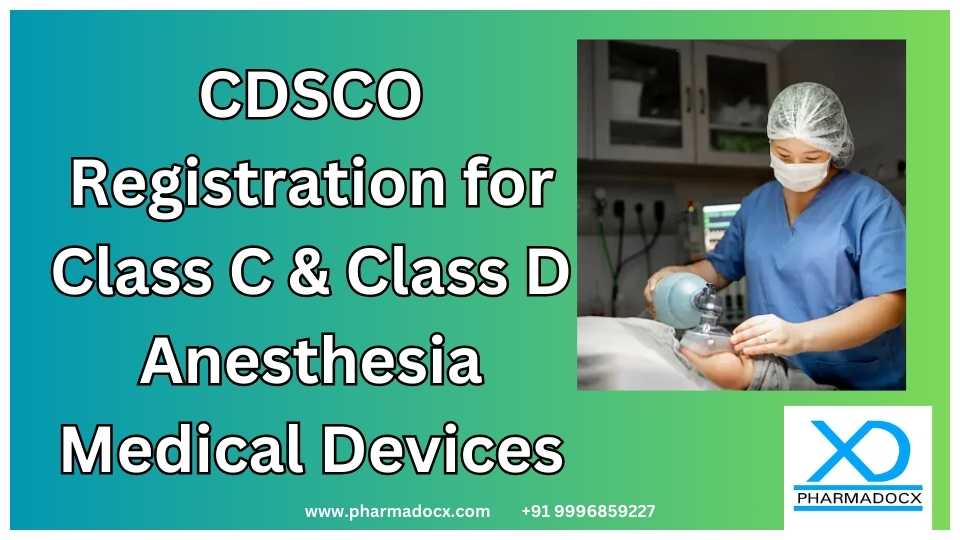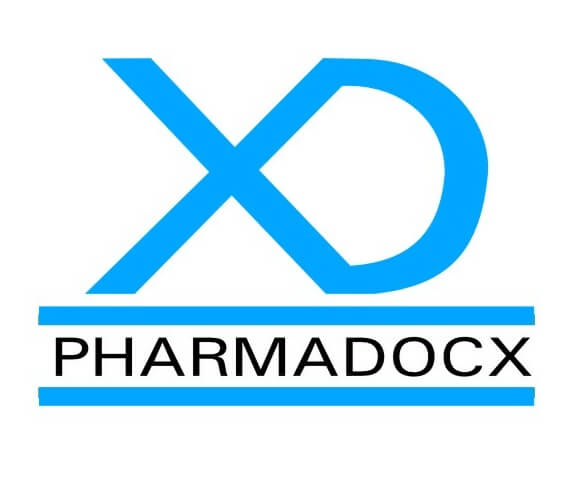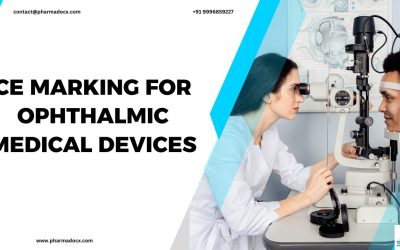The Central Drugs Standard Control Organization (CDSCO) steers the medical device regulatory ship in India. Anaesthesia devices, vital for surgeries and various medical procedures, are under the spotlight for their important role in healthcare sector. In this blog, we will provide insights into the CDSCO anaesthesia medical devices registration process.
Understanding Medical Device Classification
Anaesthesia medical devices play a crucial role in ensuring patient safety during surgeries and other medical procedures. Thus, they are stringently regulated and securing a CDSCO license is mandatory. To apply for the CDSCO anaesthesia medical device license, you need to understand the CDSCO medical device classification system. Medical devices are categorized based on their potential risks. This classification system has been developed to simplify the CDSCO license application process.
Anaesthesia medical device classes for CDSCO anaesthesia medical devices registration
We have listed few examples of medical devices belonging to the different CDSCO classes. To check which class your medical device belongs to, use our free tool.
CDSCO class A:
- Airway protection face mask: A flexible, form-shaped device that is placed over the nose and mouth to provide respiratory protection.
- Airway tube forceps: A hand-held instrument used for grasping a tube for its insertion and/or extraction into/from the airways, or for grasping obstructive objects for their removal from the airways.
- Anaesthesia catheter Luer connector: It is a device intended to create a mechanical union between an anaesthesia catheter and an external device, via a Luer connection.
- Anaesthesia depth simulator: A device intended to simulate the electroencephalography (EEG) signals of an unconscious patient.
- Anaesthesia instrument table: It is intended as a support for anaesthesia instruments used during general anaesthesia surgical procedures.
- Anaesthesia mask stabilizer: A device intended to secure an anaesthesia mask on the face of a patient typically by providing anchorage for the fixation of the mask’s headstrap.
- Anaesthesia system leakage tester: A device intended to test an anaesthesia system for leakage.
- Anaesthesia warmer: A device intended to warm the anaesthetic solutions prior to it being administered to a patient for anaesthesia.
- Bronchial cannula: A tube-shaped surgical instrument that is inserted into the lumen of the bronchus by means of a trocar blade to provide rigidity.
- Oropharyngeal airway: A curved metal or plastic tube inserted through the mouth to facilitate airway patency for gas exchange or suctioning.
- Non-rebreathing oxygen face mask: A flexible, form-shaped device designed with valve to control rebreathing and contamination of gas.
- Nose clip: A device intended to be used to compress the nose externally, to ensure that airflow is exclusively conducted through the mouth.
Class B
- Anaesthetic gas absorption/desorption device: A device intended to, when integrated within the common line of a breathing circuit, absorb and desorb (i.e., recycle) exhaled volatile anaesthetic agents.
- Artificial airway washing/disinfection jar: A container intended to hold artificial airway devices to facilitate their washing/disinfection.
- Microbial medical gas filter: A screening device intended to remove microbes from medical gases to prevent patient exposure during respiration, anaesthesia and/or endoscopy.
- Nasopharyngeal airway: A rubber or plastic tube that extends into the pharynx from either naris to maintain airway patency.
- Pulmonary function analysis system: A device used to measure the function of the respiratory system in adults and compliant children.
- Retrograde endotracheal intubation kit: A collection of devices used to assist in the placement of an endotracheal (ET) tube during difficult/emergency airway access procedures.
- Saddle block anaesthesia kit: A collection of devices designed to deliver an analgesic or anaesthetic agent to the lower dural sac.
CDSCO class C
- Anesthesia machine: A medical device used to generate and mix a fresh gas flow of medical gases and inhalational anaesthetic agents for the purpose of inducing, monitoring, and maintaining anaesthesia.
- Carbon dioxide monitor: A device intended to continuously measure the concentration of carbon dioxide (CO2) in a gas mixture to determine a patient’s ventilatory, circulatory, or metabolic status.
- High-frequency ventilator: A device intended to assist or control alveolar ventilation.
- Pulmonary resuscitator: A hand-operated device designed to provide or assist ventilation in patients who are apnoeic or exhibit inadequate respiration.
- Pulse oximeter: A device intended for the transcutaneous measurement and display of haemoglobin oxygen saturation (SpO2).
- Epidural anesthesia kit: A collection of devices intended to be used to deliver an analgesic or anaesthetic agent to the epidural space for pain management.
Class D
- Electronic epidural space locator control unit: A device intended to be used with an epidural needle and an electronic epidural space locator pressure-sensing set, to aid a user in locating the epidural needle tip within the epidural space for subsequent anaesthesia administer
- Spinal needle bioimpedance navigation unit: A device designed to transmit and receive electrical signals to/from a dedicated spinal needle.
New Guidelines for CDSCO Anaesthesia Medical Devices Registration and Licensing
CDSCO continually refines its guidelines to ensure patient safety and product efficacy. It has laid down stringent guidelines for anaesthesia medical devices, especially Class C and D devices. The focus is on rigorous testing and quality assurance before they can be used in medical settings.
The Deadline: Key Dates to Remember for Anaesthesia Medical Devices Registration and Licensing
CDSCO has rolled out changes for Class C and Class D anaesthesia devices. Previously under mandatory registration, these will now transition to a licensing system. This has been mentioned in the GSR 102(E) dated 11.02.2020, effective from October 1, 2023. For a detailed breakdown, the official CDSCO circular is a valuable resource.
Anaesthesia Medical Devices Registration and Licensing Requirements
- Class A and B anaesthesia devices: MD 5 License is required. Moreover, Rs. 5,000 for the manufacturing license and Rs. 500 for each distinct device have to be paid. The license has to be obtained from the state licensing authority.
- Class C and D anaesthesia medical devices: MD 9 License is required. Moreover, a fee of Rs. 50,000 for the manufacturing license and Rs. 1,000 for each distinct device is required. The license has to be obtained from the central licensing authority.
- Importing anaesthesia devices into India: MD 15 Import License has to be secured from the CDSCO to import anaesthesia medical devices into India.

Documents Required for CDSCO Anaesthesia Medical Devices Registration
We have provided an overview of the documents required for securing CDSCO anaesthesia medical device license.
- Building Layout with Dimension
- Organization identity proof
- Sale Deed/Rent Deed of the Premises
- Plant Master File
- Device Master File
- Documents for the team of qualified and experienced staff who can manufacture and test your medical devices.
- Test License, if required for testing the anaesthesia medical device
- Certificate of analysis of 3 consecutive batches
- ISO 13485 Certificate
- Environmental regulation compliance documents
CDSCO Anaesthesia Medical Devices Registration and License Application Process Simplified
- Documentation: Collate all necessary documents, including clinical trial data and product specifications.
- Application Submission: File the application online.
- Query Resolution: Address any queries raised by CDSCO.
- Inspection: Prepare for CDSCO’s inspection phase.
- License Approval: Once compliant, CDSCO will grant the license.
Common CDSCO License Application Challenges and How to Overcome Them
Potential challenges faced during CDSCO anaesthesia medical devices registration are:
- Documentation Gaps: Ensure all documents are current and meet CDSCO’s standards.
- Delays in Query Resolution: Have a dedicated team to address CDSCO queries.
- Inspection Hurdles: Regularly review facilities to ensure they align with CDSCO guidelines.
How Can Pharmadocx Consultants Assist in Navigating CDSCO Anaesthesia Medical Devices Registration?
Pharmadocx Consultants comprehensive service includes the following:
- Expert Guidance: Assistance at every step.
- Mock Audits: Pre-inspection mock audits to ensure readiness.
- Query Resolution: Prompt resolution of CDSCO queries.
- End-to-End Support: Comprehensive support from application to license approval.
Mandatory CDSCO registration for anaesthesia devices ensures that healthcare professionals have access to safe and effective tools. With the help of Pharmadocx Consultants, your CDSCO regulatory journey will be streamlined. Need assistance with the CDSCO anaesthesia medical devices registration? Contact Pharmadocx Consultants today for expert guidance!





